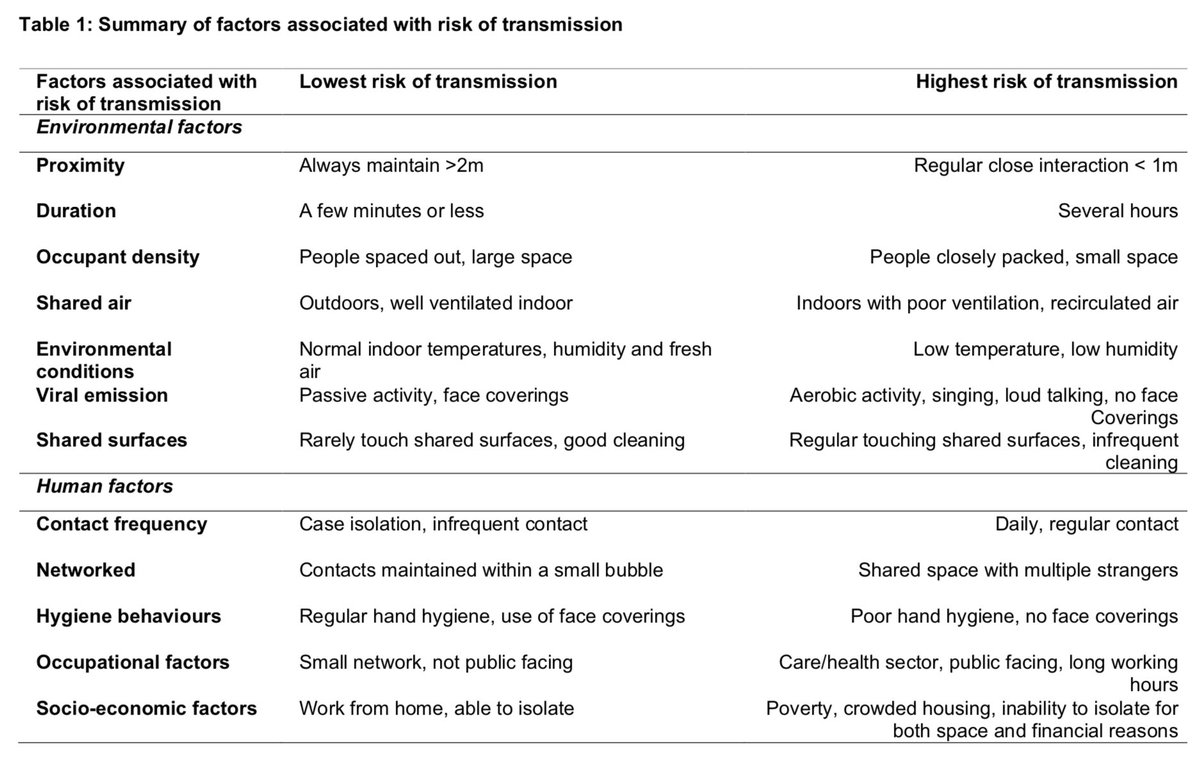Concerns about outdoor transmission risk seem to be trending again. What is the risk of transmission outdoors and should we be more worried about outdoors with the new more-transmissible variant?  (1/n)
(1/n)
 (1/n)
(1/n)
The risk of transmission is complex and multi-dimensional. It depends on many factors: contact pattern (duration, proximity, activity), individual factors, environment (e.g. outdoor, indoor), socioeconomic factors, and mitigation measures in place. (2/n)( https://www.gov.uk/government/publications/sars-cov-2-transmission-routes-and-environments-22-october-2020\\)
Transmission is facilitated by close proximity, prolonged contact, and frequency of contacts. So, the longer the time you spend with an infected person and the larger the gathering, the higher the risk is. (3/n) ( https://academic.oup.com/cid/advance-article/doi/10.1093/cid/ciaa1442/5910315\\)
But what is the likelihood of catching the virus outdoors? Contact tracing studies suggest that transmission risk is 20 times higher in indoor settings compared with outdoor environments. The risk is not zero but significantly lower. (4/n)
( https://academic.oup.com/cid/advance-article/doi/10.1093/cid/ciaa1442/5910315\\)
( https://academic.oup.com/cid/advance-article/doi/10.1093/cid/ciaa1442/5910315\\)
And we know that the majority of transmission (>90%) occurs indoors. Sharing the same sleeping space, frequent daily contact, engaging in group activities such as dining are high risk. So, the risk increases with longer & frequent exposure, close proximity, # of contacts. (5/n)
The small number of cases where outdoor transmission might have occurred were associated w/close interactions, particularly extended duration, or settings where people mixed indoors alongside an outdoor setting. (6/n)
( https://academic.oup.com/jid/advance-article/doi/10.1093/infdis/jiaa742/6009483\\) & ( https://www.medrxiv.org/content/10.1101/2020.09.04.20188417v2\\)
( https://academic.oup.com/jid/advance-article/doi/10.1093/infdis/jiaa742/6009483\\) & ( https://www.medrxiv.org/content/10.1101/2020.09.04.20188417v2\\)
Therefore, outdoor risk is negligible unless it involves close interaction or you are in a crowded or semi-outdoor environment. For example, walking on the street with no f2f contact, or passing by a jogger, the risk is very low as the duration of interaction is brief. (7/n)
With the new variant, all interactions are higher-risk, but outdoor risk is still relatively low. Most importantly, given very high community prevalence, you are much more likely to encounter someone infected now than a few months ago. (8/n) https://twitter.com/mugecevik/status/1341094836682838021?s=20
Of course, we still need to show respect to others and their personal space outdoors, even though it’s low risk. But a recurring theme on social media and in the news is shaming people for spending time outside, when really this is one of the safer places. (9/n)
There are 4 main problems with concentrating on low-risk settings and restricting/shaming outdoor interactions.
1- These messages are quite harmful because people are confused about where the real risk is. Majority of transmission continues to happen in indoor settings. (10/n)
1- These messages are quite harmful because people are confused about where the real risk is. Majority of transmission continues to happen in indoor settings. (10/n)
2- There's a delicate balance between preventing infections and increasing lockdown fatigue. People do not have unlimited energy, so we should ask them to be vigilant where it matters most, which is indoors, while giving them a break outdoors. (11/n)
3- We have to assume that not everyone will be able completely eliminate social interaction for extended periods of time, especially people who live alone, so restricting outdoor activity will likely result in some people gathering indoors, where the risk is higher. (12/n)
4- Focusing on low-risk settings diverts us away from addressing structural factors driving majority of transmission. Higher cumulative infection rates are observed among those working in low paid, public facing jobs & living in crowded households. (13/n) https://twitter.com/mugecevik/status/1308080084033638405?s=20
So, I can’t see how blanket "tougher" measures will help much now. Smarter response is urgently needed; making work places safer, invest in supportive measures for those who are disproportionately affected such as housing, income relief. (14/n) https://www.theguardian.com/commentisfree/2021/jan/08/lockdowns-workers-restrictions-self-isolate
For example, there is international consensus that those living in crowded households have 2-3x higher risk of infection. Housing in socioeconomically deprived areas is more likely to be overcrowded, increasing the risk of transmission. (15/n) ( https://www.gov.uk/government/publications/phe-factors-contributing-to-risk-of-sars-cov2-transmission-in-various-settings-26-november-2020\\)
While there's been a lot of emphasis on testing, we haven't emphasised isolation enough. One simple measure, financial & social support for isolation, could make a huge difference. Here I discussed ways to scale up isolation w/ @vcallier (16/n) https://www.nationalgeographic.com/science/2020/12/shorter-quarantines-could-help-prevent-coronavirus-outbreaks/
Individually, we need to avoid / spend as little time as possible in crowded poorly ventilated indoor settings & wear a mask indoors/transport. Spend time outdoors. Open windows. Maintain distance, wash hands and engage in shorter interactions. (17/n) https://twitter.com/mugecevik/status/1308082671302651904?s=20
If you are interested in understanding more about transmission dynamics and high risk settings, I suggest some additional reading material.
Here is a thread based on our article published in CID summarising international data on transmission. (18/n) https://twitter.com/mugecevik/status/1308080056384843777?s=20
Here is a thread based on our article published in CID summarising international data on transmission. (18/n) https://twitter.com/mugecevik/status/1308080056384843777?s=20
In this article, we summarised international and UK contact tracing data, looking at transmission associated with households, occupational settings, transport and social/leisure settings. (19/n) https://www.gov.uk/government/publications/phe-factors-contributing-to-risk-of-sars-cov2-transmission-in-various-settings-26-november-2020
This is a fantastic article by @B_resnick where we discussed 4 ways to think about Covid-19 risk: Distance, time, activity, environment. (20/n) https://www.vox.com/science-and-health/2020/5/22/21265180/cdc-coronavirus-surfaces-social-distancing-guidelines-covid-19-risks
In this interview, we discussed the key misunderstandings about transmission - BBC @sciencefocus (21/n) https://www.sciencefocus.com/science/coronavirus-misunderstandings-muge-cevik/
While blaming rule-breakers is satisfying & easy, "psychologising and individualising the issue of adherence, one disregards the structural factors which underlie the spread of infection." This is a great article by @ProfJohnDrury @ReicherStephen (22/n) https://blogs.bmj.com/bmj/2021/01/07/pandemic-fatigue-how-adherence-to-covid-19-regulations-has-been-misrepresented-and-why-it-matters/
Further thoughts about outdoor risk, why shaming people for spending time outside is counterproductive, where we should be focusing right now. Discussed w/ Evan Davies @EvanHD @BBCRadio4 PM program - you can listen via link @ 5:20pm GMT today. (23/n) https://www.bbc.co.uk/sounds/play/m000r36n
Need to be careful with car share because of close proximity of people in a confined space. I would recommend avoiding car-share w/non-households, or take a short ride + open windows + use mask only if you have to. Check tweet #19 for more details. https://twitter.com/sue_strachan/status/1348906808744796160?s=20

 Read on Twitter
Read on Twitter






